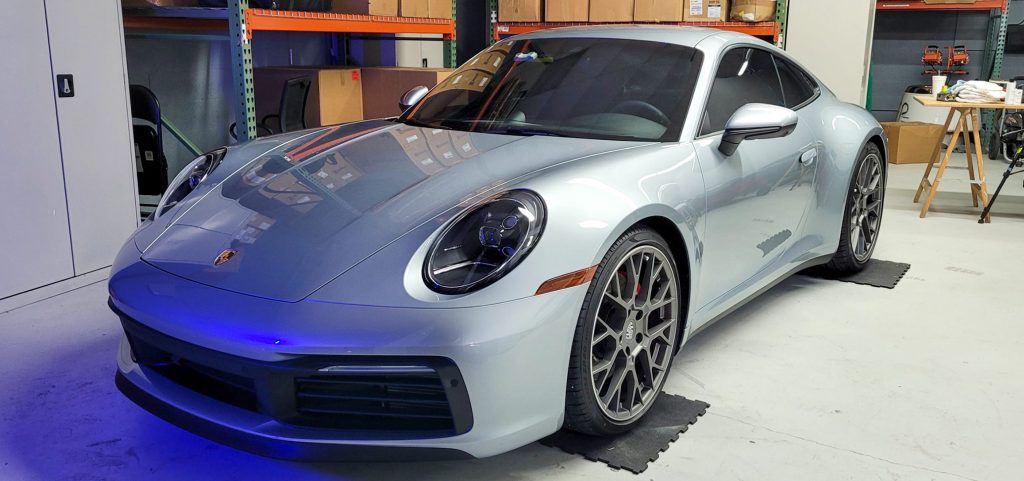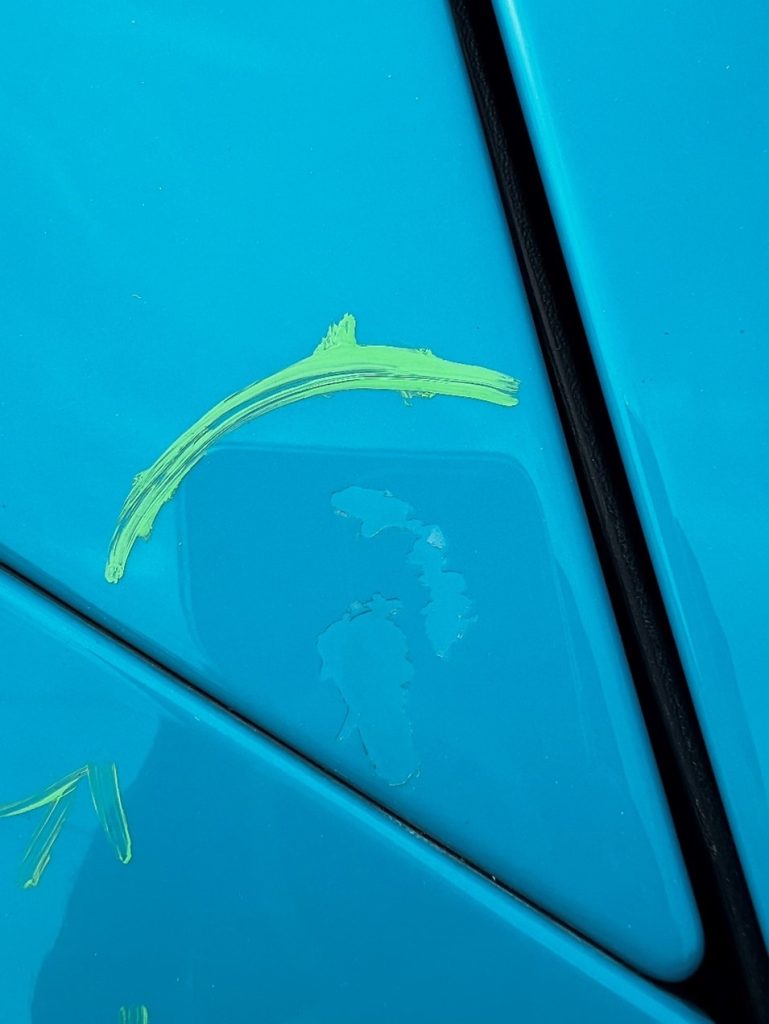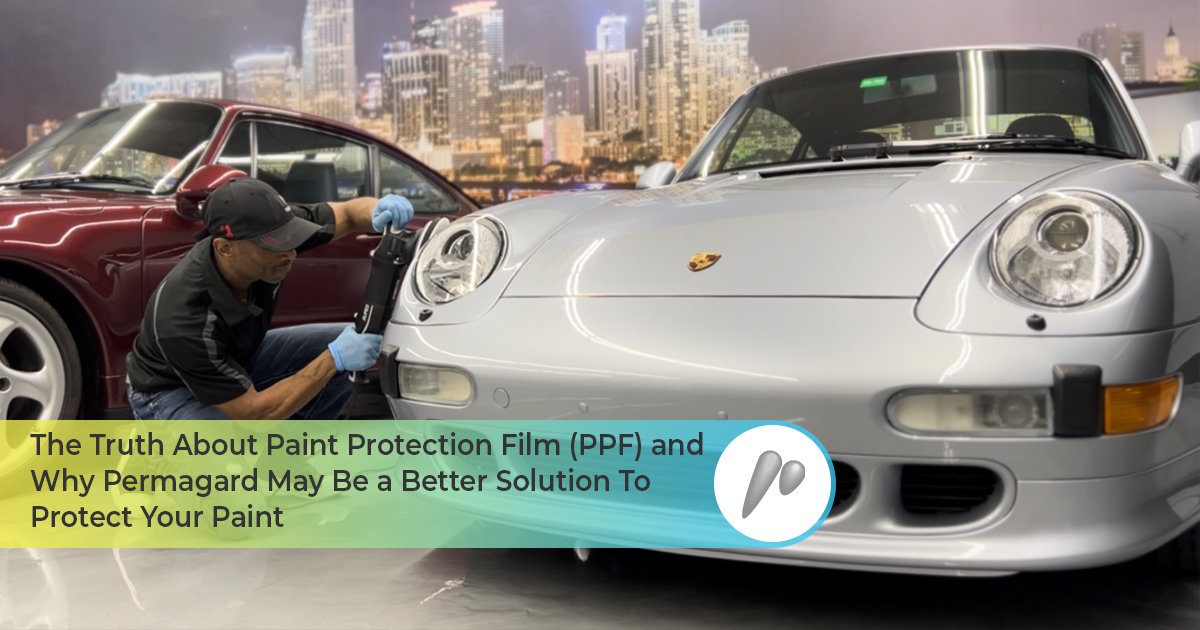This article will cover some of the disadvantages of paint protection film and why it may not be the best option to protect your car’s original paint.
The Limitations of Paint Protection Film
Paint protection film has been available to automotive consumers for roughly 30 years now. During that time, the paint protection film market has seen many improvements to its durability from manufacturers. However, the technology is still not there to support the full protection of original paint. Paint protection film’s primary purpose is to protect your car’s original paint from rock chips. It is effective in serving that purpose provided it does not penetrate the film. A customer who chooses to have PPF installed is probably quite a meticulous individual. When a rock hits the PPF, it leaves a perforation in the film that stands out like a sore thumb. This damage looks far worse than just a rock chip in paint, as the film is a thick elastic plastic, therefore making the damage stand out even more. Once this happens, the film has to be replaced, until your next rock chip. That’s not a very good value for something as expensive as PPF. Applying Permagard to a vehicle with no PPF to maintain the clearcoat and using touchup paint on areas with rock chip impacts looks far better and is much a better value for the lifetime of your vehicle. If too many rock chips do appear in the paint over time, repainting the hood and/or bumper is far more time-efficient and cost-effective than having new PPF installed.

Is Paint Protection Film Worth It?
Paint protection film is incredibly expensive. For a high-impact installation (front of the hood and bumper), it can cost up to $1,500. For a full frontal installation (whole hood, bumper, and fenders), that price can go up to $2,500. And for a full vehicle installation of paint protection film, the price can reach as much as $10,000. If paint protection film can be penetrated by a rock chip and damage your paint, why would someone pay these exorbitant prices if they have to be paid again in 3-5 years? Paint protection film was designed to protect your paint, which it does. But it does not protect it as much as the manufacturers want you to believe. Also, if you only PPF partial sections of your vehicle, this will cause uneven paint wear over time. The parts of your car that are not protected with PPF will degrade naturally over time. Therefore, when the PPF is removed, the paint will be uneven. This is due to the clearcoat remaining untouched on areas that have PPF and natural wear on the clearcoat over time on areas that are not protected with PPF. Unfortunately, this is irreversible and can only be fixed by repainting the entire car. If you install PPF to the entire vehicle and apply Permagard on top of the PPF, you would prevent this from happening in the long run.

Uneven Wear and Potential Damage
PPF can also yellow over time due to it being a plastic-based product. Think of a clear case that you might’ve used for your phone before. Did it still look clear after owning it for 6 months? How about a year? This is true for PPF as well. Applying a paint protection product, such as Permagard, to the PPF would slow down yellowing process. However, it would still be visible after a few years of use. This is due to the clear elasticity of the product itself. Dirt lines can also appear on the surface of poorly installed PPF. This comes from installers not wrapping edges and corners to prevent this from happening. You also run the risk of inexperienced installers cutting your paint (due to using an edge knife when cutting the film to fit the car), if you opt for a custom kit install. The worst part of it is you won’t even notice the cuts on your paint until the PPF is removed. That’s a big risk to take. Experienced installers will wrap edges and corners, but you will end up paying a premium price for their services. The risk is also great if you decide to remove PPF from your car altogether. Aside from uneven paint, if you opted for a partial install, you also risk the installer removing paint when removing the PPF from the vehicle. This is common in manufacturers’ vehicles that have softer paint, such as Lexus, Porsche, and Ferrari. That would be a very expensive mistake to correct. In fact just recently, one of our Permagard Automotive installers (Oscar Cardenas from European Collison Center in South Miami) showed us exactly what the risk is when you remove PPF from a Porsche. As you can see, the results are quite alarming. The clearcoat was removed WITH the PPF! And now, Oscar is tasked with giving this Porsche a full repaint. This is a clear example of why Permagard is a much better and safer option for your paint.


Long-Term Effects of PPF
Coleton, from Out of Spec Detailing in Fort Collins, Colorado, also clearly explains these issues in the video below. His deep dive into a customer’s PPF showcases his terrific knowledge about automotive detailing. And as you will hear him say, he no longer offers PPF to his customers. For a beautiful royal blue Mercedes SUV that’s only 6 months old with 3,500 miles on it, the condition of its PPF is quite shocking.
Exploring the Benefits of Permagard Over PPF
Permagard protects 100% of your vehicle’s original paint system. Rock chips are a natural part of owning a vehicle. Whether it’s a Honda Civic or a Porsche 911, they will inevitably happen. As long as your paint is protected from the elements and corrosion, then you can rest easy. Rock chips can be touched up. Uneven paint from partial PPF installs, damaged paint from PPF removal, and cut paint from an edge knife used in a PPF installation would require a complete repaint of your vehicle. Protecting your paint with Permagard is much more viable than putting your car or supercar in a bubble. In due time, that bubble will burst and you’ll be left with thousands of dollars in expenses from PPF. The best use case for PPF is for rare and exclusive vehicles that lose tons of value once their panels are repainted, such as Pagani, Bugatti, Koenigsegg, etc., since the original paint on these multimillion dollar supercars is so valuable and expensive.
The Permagard Solution: A Superior Alternative to PPF
Paint protection film can only go so far with protecting your paint. It’s not cost-effective, it can still be damaged, and you’ll encounter many other issues due to having it installed on your vehicle. Permagard is the best non-invasive form of paint protection to protect your car’s original paint, while enhancing its color vibrancy to bring a rich depth of shine that cannot be replicated by competitive products.
If you would like to learn more about the differences between Permagard and PPF, and how Permagard is the best option for your automotive paint protection, give our Permagard Headquarters office a call today at 305-662-5070 for more information. It’s time to shine and see yourself in your brand!

